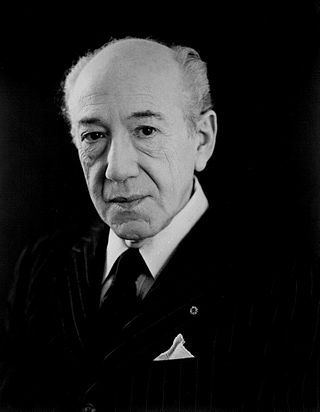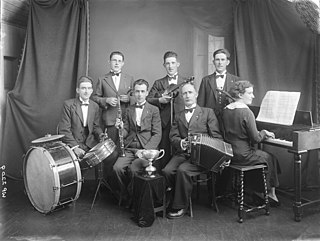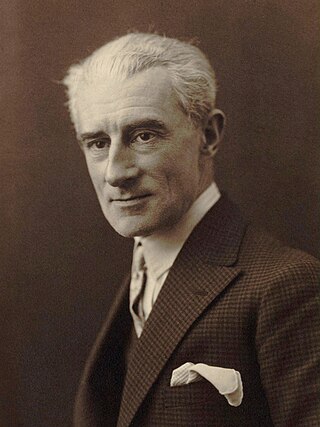Related Research Articles

The Concerto for Orchestra, Sz. 116, BB 123, is a five-movement orchestral work composed by Béla Bartók in 1943. It is one of his best-known, most popular, and most accessible works.

David Leo Diamond was an American composer of classical music. He is considered one of the preeminent American composers of his generation. Many of his works are tonal or modestly modal. His early compositions are typically triadic, often with widely spaced harmonies, giving them a distinctly American tone, but some of his works are consciously French in style. His later style became more chromatic.

Sergei Prokofiev wrote his Symphony No. 2 in D minor, Op. 40, in Paris in 1924-25, during what he called "nine months of frenzied toil". He characterized this symphony as a work of "iron and steel".

A septet is a formation containing exactly seven members. It is commonly associated with musical groups but can be applied to any situation where seven similar or related objects are considered a single unit, such as a seven-line stanza of poetry.

Maurice Ravel's Piano Concerto in G major, was composed between 1929 and 1931. The piano concerto is in three movements, with a total playing time of a little over 20 minutes. Ravel said that in this piece he was not aiming to be profound but to entertain, in the manner of Mozart and Saint-Saëns. Among its other influences are jazz and Basque folk music.
Bernard Rands is a British-American contemporary classical composer. He studied music and English literature at the University of Wales, Bangor, and composition with Pierre Boulez and Bruno Maderna in Darmstadt, Germany, and with Luigi Dallapiccola and Luciano Berio in Milan, Italy. He held residencies at Princeton University, the University of Illinois, and the University of York before emigrating to the United States in 1975; he became a U.S. citizen in 1983. In 1984, Rands's Canti del Sole, premiered by Paul Sperry, Zubin Mehta, and the New York Philharmonic, won the Pulitzer Prize for Music. He has since taught at the University of California, San Diego, the Juilliard School, Yale University, and Boston University. From 1988 to 2005 he taught at Harvard University, where he is Walter Bigelow Rosen Professor of Music Emeritus.
Christopher Chapman Rouse III was an American composer. Though he wrote for various ensembles, Rouse is primarily known for his orchestral compositions, including a Requiem, a dozen concertos, and six symphonies. His work received numerous accolades, including the Kennedy Center Friedheim Award, the Grammy Award for Best Classical Contemporary Composition, and the Pulitzer Prize for Music. He also served as the composer-in-residence for the New York Philharmonic from 2012 to 2015.

Philippe Gaubert was a French musician who was a distinguished performer on the flute, a respected conductor and a composer, primarily for the flute.

La valse, poème chorégraphique pour orchestre, is a work written by Maurice Ravel between February 1919 and 1920; it was first performed on 12 December 1920 in Paris. It was conceived as a ballet but is now more often heard as a concert work.

The Concerto for Flute, Harp, and Orchestra in C major, K. 299/297c, is a concerto by Wolfgang Amadeus Mozart for flute, harp, and orchestra. It is one of only two true double concertos that he wrote, as well as the only piece of music by Mozart for the harp. The piece is one of the most popular such concertos in the repertoire, as well as often being found on recordings dedicated to either one of its featured instruments.
Wolf Rounds is a musical composition for wind ensemble by the American composer Christopher Rouse. It was commissioned by the University of Miami-Frost Wind Ensemble and its conductor, Gary Green, who premiered the work at Carnegie Hall, New York, on March 29, 2007. Wolf Rounds was completed in Baltimore, Maryland on October 16, 2006, and lasts approximately seventeen minutes in performance. It is scored for piccolo, two flutes, three oboes, two clarinets, bass clarinet, two bassoons, contrabassoon, baritone saxophone, bass saxophone, four horns, three trumpets, three trombones, tuba, timpani, percussion, and string bass (amplified).
David Horne is a Scottish composer, pianist, and teacher.
The Melos Ensemble is a group of musicians who started in 1950 in London to play chamber music in mixed instrumentation of string instruments, wind instruments and others. Benjamin Britten composed the chamber music for his War Requiem for the Melos Ensemble and conducted the group in the first performance in Coventry.

Laura Elise Schwendinger was the first composer to win the American Academy in Berlin's Berlin Prize.
Introduction and Allegro for Harp, Flute, Clarinet and String Quartet is a chamber work by Maurice Ravel. It is a short piece, typically lasting between ten and eleven minutes in performance. It was commissioned in 1905 by the Érard harp manufacturers to showcase their instruments, and has been described as a miniature harp concerto. The premiere was in Paris on 22 February 1907.
Konzertmusik für Streichorchester und Blechbläser, Op. 50, is a work by Paul Hindemith, composed in 1930. It was one of a large group of pieces commissioned for the 50th anniversary of the Boston Symphony Orchestra by its music director, Serge Koussevitzky. Koussevitzky conducted the premiere of Hindemith's work with the Boston Symphony Orchestra on 3 April 1931.
The Concerto for Orchestra is an orchestral composition by the American composer Christopher Rouse. The work was commissioned by the Cabrillo Festival of Contemporary Music and is dedicated to conductor and frequent Rouse collaborator Marin Alsop. The piece was completed February 24, 2008 and premiered at the festival August 1, 2008, with Marin Alsop leading the Cabrillo Festival Orchestra.

Concert de Gaudí is a concerto for classical guitar and orchestra by the American composer Christopher Rouse. The work was jointly commissioned by Norddeutscher Rundfunk and the Dallas Symphony Orchestra for the guitarist Sharon Isbin, with additional contributions from Richard and Jody Nordlof, to whom the piece is dedicated. It was completed August 1, 1999 and premiered in Hamburg, January 2, 2000, with Isbin and the Norddeutscher Rundfunk Orchester led by conductor Christoph Eschenbach. The piece was later awarded the 2002 Grammy Award for Best Classical Contemporary Composition.
Claude Debussy's Six sonatas for various instruments was a projected cycle of sonatas that was interrupted by the composer's death in 1918, after he had composed only half of the projected sonatas. He left behind his sonatas for cello and piano (1915), flute, viola and harp (1915), and violin and piano (1916–1917).
References
- 1 2 3 4 Rouse, Christopher (1996). Compline: Program Note by the Composer. Retrieved July 28, 2015.
- 1 2 Holland, Bernard (December 10, 1996). "A Chamber Piece Custom-Made to Balance a Program". The New York Times . Retrieved July 28, 2015.
- ↑ Taylor, James C. (March 10, 2004). "Green Umbrella offers Stucky premiere". Los Angeles Times . Retrieved July 28, 2015.
- ↑ Rich, Alan (March 18, 2004). "Wise Counselor". LA Weekly . Retrieved July 28, 2015.